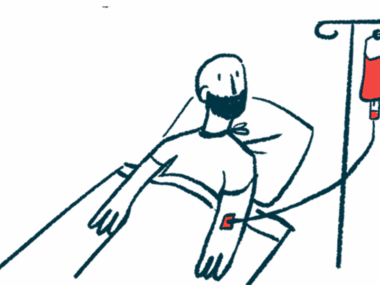My Dinner Plate Theory Helps Explain Daily Energy Levels
Written by |

“Stick a fork in me, I’m done!”
“I don’t have enough spoons for this.”
We’ve all heard various quips involving silverware. When one becomes part of the chronic illness family, they may adopt the term “spoonie,” based on the spoon theory, a metaphor coined by lupus patient Christine Miserandino. Essentially, the spoon theory is a visual way to help those without chronic illness understand our energy levels and how much energy we require for everyday tasks. Wendy Henderson explains the concept further over at our sister site Multiple Sclerosis News Today.
For the past three years, I’ve been working on my own theory. Inspired by the times when my myasthenia gravis (MG) doesn’t play nice, my dinner plate theory starts with the daily foundation of the dinner plate, followed by tasks that are categorized as spoons, forks, or knives.
Dinner plate foundation
All the tasks we must do each day are piled onto the dinner plate. If there are too many tasks and the plate gets buried before we can even begin clearing it, that’s an issue. The dinner plate becomes the overloaded turkey platter at Grandma’s house on Thanksgiving, because heaven forbid you don’t get to experience all the things!
If our plates start off too full, we set ourselves up for failure. This doesn’t do us, our family, our friends, or our co-workers any good. Setting realistic expectations about your abilities is important. With MG, this may look different day to day. Identifying how big your plate is at the beginning of the day will help set you up for success. With time, this gets easier.
For me, I wake up, eat breakfast, and take my meds. I enjoy at least a full hour of downtime and coffee drinking before I do a self-assessment to see where my fatigue levels are. Did I wake up droopy or short of breath? Do my legs or arms feel weighted down or heavy? After this self-assessment, I consider all the tasks I need and want to get done, and determine how many of them can reasonably fit on my plate.
Spoons
Spoon tasks require the least amount of energy, but they bring the greatest sense of joy and accomplishment when completed. These may include household tasks like daily hygiene or chores. For me, they include showering, brushing my teeth, helping with the dishes, creating art in my studio, writing articles, eating, updating websites, and driving to appointments.
Forks
Fork tasks are energy intensive — something that will completely kill your day or drain you of energy quickly, requiring a longer recovery. Fork tasks can be positive or negative. For me, they include therapy and physical therapy appointments, prolonged activity, such as walking or rolling around a large store or an event (I often use my wheelchair for these things), and working a regular job.
Knives
Knife tasks are things that I’ve completely cut out of my life because they are too taxing. I include them in my dinner plate theory as a reminder to keep it simple.
The number of forks and spoons an activity requires will vary. For example, let’s say I start the day off with energy levels equaling two forks and 10 spoons. That means I can do one fork activity in the morning and one in the afternoon, with spoon activities scattered about.
If I have a therapy appointment in the morning, that’s a fork. I might eat breakfast (one spoon), try to shower (two or three spoons), and brush my teeth (one spoon) in the morning, and that’s it.
After lunch (one spoon), I decide I want to get some walking in (one fork). With frequent rest periods, I should be able to get my walk in, do the dishes (two spoons), work on website updates (one spoon), and create some art (two spoons).
Knowing my body, accepting my limitations, and living within them has drastically improved my quality of life.
Not everyone will understand the boundaries you set for yourself. It may take some time for you to be OK with implementing boundaries that keep your dinner plate from overflowing, as it may cause you to lose people that don’t, won’t, or can’t understand. If this happens, and it’s someone you truly want in your life, let them know that they have an open invitation to come sit at your table.
I am doing less and living more since implementing my dinner plate theory. It makes it easier for me to not only plan my day, but to explain to my husband how my day will look. It helps us communicate which tasks I plan to do instead of others. For instance, I’d rather spend my spoons getting my home studio set up than helping with household chores because it’s important for my mental health.
So what’s on your plate? Please share in the comments below.
Myasthenia Gravis News is strictly a news and information website about the disease. It does not provide medical advice, diagnosis or treatment. This content is not intended to be a substitute for professional medical advice, diagnosis, or treatment. Always seek the advice of your physician or other qualified health provider with any questions you may have regarding a medical condition. Never disregard professional medical advice or delay in seeking it because of something you have read on this website.







Norm
I've been surprised and pleased to see how much can be done by dividing difficult tasks into multiple "spoons." Even many "knives" can be accomplished if broken down into easy pieces.
Shawna Barnes
Agreed, Norm. For me, the knives are more of an emotional burden that I choose to not worry about. Letting go of negativity, engaging in drama, and running a marathon. ha
Neil Cowan
Back to my pie of Energy. Yesterday it used 25% to take a shower and shave. I went out to dinner with out-of-town friends wearing a white linen suit and a bright Ukranian Mariupol T-shirt. I had a “Martini”, really just a glass of gin. At home it’s easy because I’m in bed. My sea bas feuilleté was divine as usual. Towards the end of it I had a slight mishap with a bite. At this point I was in the restaurant over an hour. I sipped a bit of Baume de venise that was divine but I shared. They had a raspberry feuilleté which was one more feuilleté than I could handle so I didn’t.
At home getting undressed, especially taking off socks. The pie was exhausted. I fell into a deep sleep until more pie was baked.
This expedition was taken 4 days after my fourth Vyvgart infusion, so there’s no physical improvement yet but mentally and emotionally I feel much better. After some blood work I’ll see my neurologist and plot the next infusion.
Lesson: the pie is finite and if you venture out you have to return. BTW it was great fun and I’d do it again- just not right away.
Neil Cowan
Last night I woke up at 1 AM and got up and opened the slider because it has cooled off enough. I then walked into the kitchen and back all without my cane it’s been six days since my Vyvgart treatment and my dizziness is gone and my emotional outlook has skyrocketed. I can’t wait to report to the doctor and find out what’s next.
Shawna Barnes
I love your pie analogy, Neil! It's funny how we all find ways to help explain our capabilities so others can understand. There are days where I spend ALL my spoons and forks on a single activity knowing it will take me a few days to recover. In the moment it is worth it; our mental and emotional health is just as important as our physical and sometimes those are just the tradeoffs.
Cheryl Carlson
Triple sero neg, strong mestinon responder given instructions to "Play with dose" 18 mos ago.Much has gotten better but if I want to go somewhere, do anything, I have to plan 2 days ahead and still be wiped out for 1 day after. Had Covid a second time and back to feeling like not on Mestinon. Hips and low back are wobbly,arms and thighs are so heavy can't even hold knitting needles or stand up to put clothes in the dresser.
Shawna Barnes
I have to plan activities and outings in advance as well as schedule recovery days as well. It can definitely be frustrating. Thank you for sharing your experiences with us. - Shawna
John Miller
I also struggling in the morning, I try to maintain a schedule of sorts in the morning or I don’t get anything done . Besides my Myasthenia, I also had stroke a little over a year ago,so my right side is numb. I can walk,but slide my right leg . Myasthenia affects my neck muscles and my eyes and speech later in the day. .Have been through a lot therapy., walking and speech and therapy,I still live in my own house, have put up handrails. It’s so hard not to get really depressed. I’m an avid reader so enjoy a good book. Hang in there everybody , this life can be tough.
Wanda Bales
I divide my chores into the week: Monday and Tuesday doctor appointments, Wednesday groceries, Thursday dusting & vacuuming, Friday scrubbing the bathroom, Saturday laundry, Sunday is day of rest. If I need to skip something because of lack of energy, I will get to it next week. I try to accomplish tasks in the morning so I can rest before fixing supper. If I can't fix supper, there's always frozen or delivery. I've had my second dose of Ultomiris and find I can do so much more now. I've doubled my walking and don't stress as much in the afternoons about what I can get done. I'm grateful for these blogs because I don't feel alone. It helps to know other people struggle what used to be normal. At one time, I worked full time, took care of my family, had two girl scout troops, and attended college at night. Now I'm retired and grateful I don't have to work with Myasthenia. I catch when I'm starting to droop and can stop to rest.
Shawna Barnes
Hi Wanda! I feel ya. I used to be able to operate on 4 hours of sleep when I was in the Army, packing my day full of required tasks then going home to my young son and doing "all the things". It's been difficult to adjust, but by sharing what has worked for me, it helps me see just how far I've come as well. I'm glad to see that Ultomiris is working for you and I hope that it continues to do so!
Wanda Bales
Thank you all for sharing. I remember thinking when I was young that if senior citizens just kept doing things, they wouldn't slow down when they aged. 50 years later, I know better :-) that we all do what we can when we can. If the most a person can do is dress, shower, eat, and go to the bathroom - that is an accomplishment. I was bed-bound with a wheelchair for too long of a time and I'm so grateful for the strength today to be able to stand without help and do activities. I'm thankful for the medicines that work to keep the symptoms minimal. I'm also grateful to know that I'm not alone in the struggle, that other people struggle to do activities. I'm slowly regaining activities outside of the house and meeting people I used to see on a regular basis. Don't ever give up; life is too precious!
Melanie Higgins
Hi Shawna! You know my husband, Bob Higgins. You both received service dogs from K9's on the Front Line! He told me of your story, back when I was having symptoms that were arising after getting vaxxed and getting Covid. I am sero neg as well. Being treated with prednisone for the last year and half. Some months are much harder than others, then some I can feel really well. But, always my tell tale is ptosis, slurring, drooping and extreme fatigue. I've learned how to pace and plan and the worst of all ASK FOR HELP! LOL ~ thankfully, my husband and family are super stars and work around my symptoms and make life less chaotic for me. For which, chaos and stress can really do a number on me too. Thank you for your article, wise words for sure. God Bless.
Mary Stricklin
When I wake up in the morning, I lay a stretch my legs and arms to see how strong they feel l, before trying to stand. If I feel weak, I take my Mestinon tablet laying on the nightstand within arms reach. Within 30 minutes I have the strength to get up. Sometimes requires 2 tablets, as I have been given the freedom to adjust my dose.
I plan my day according to the strength I have. Sometimes that means canceling an outing, doing laundry a different day. Every day is a roll of the dice. Most people do not understand that. I have quit trying to muscle through just to make others happy, it takes me days to recover. Some days are meant to just listen to music, read, or sleep.
I have finally accepted that on some days I can’t do the things I used to do. Plan a small spoon activity instead.
Debra Rice
Anyone with MUSK. Mg? What medication are you taking?
Robert stern
In addition to MG, I am recovering from multiple (4) spinal surgeries. I'm also an octogenarian so I feel like I have 2 1/2 strikes against me. Lethargy, lack of ambition, systemic weakness: the trifecta of yuck. I've only recently been diagnosed so my previously unexplained symptoms are beginning to make sense. I learn from every comment I read and am grateful for the sharing.